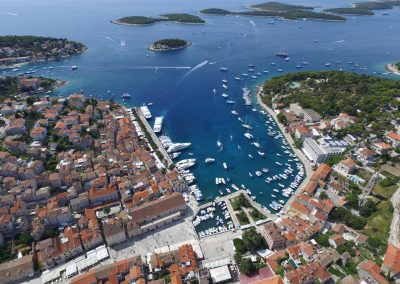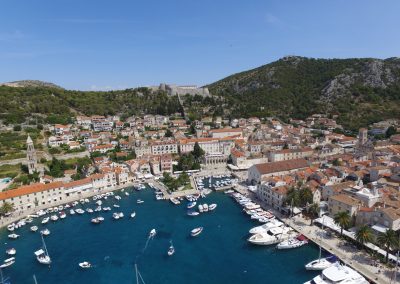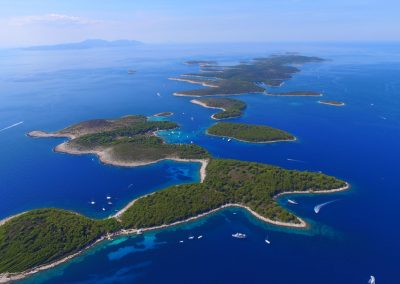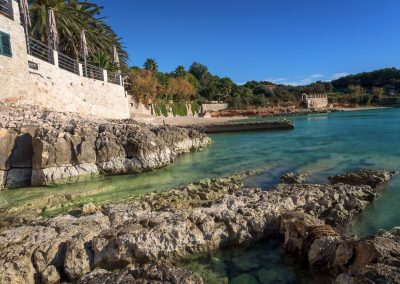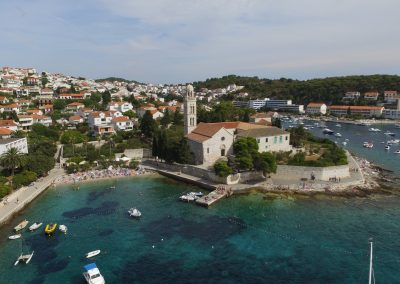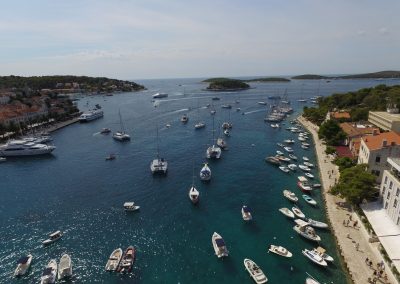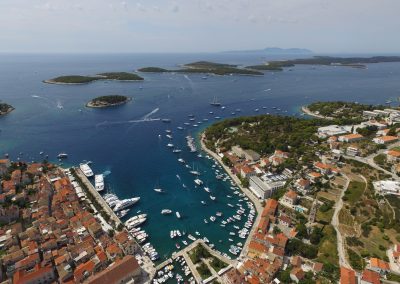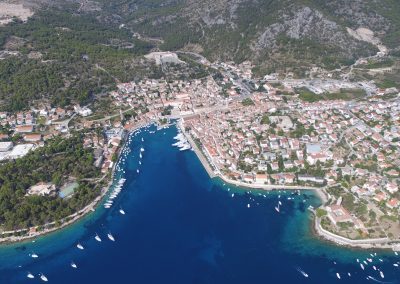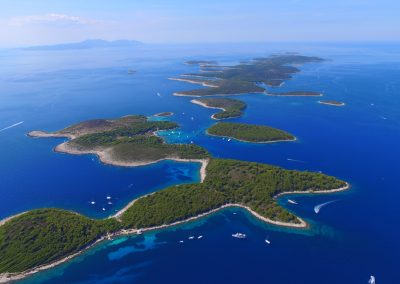Otkrijte Hvar
SLIKE OTOKA HVARA HR
O HVARU
During Middle Ages, Hvar was very important port within Naval and Venetian Empire. Pleasant climate of rich Mediterranean vegetation of aloes, pine trees, palms, lavender and beautiful coves is what island Hvar offers to visitors from all around the world.
Located in central Dalmatia on the Adriatic Sea in Croatia, surrounded by pine forests, ancient olive trees and shrouded with a sent of lavender lying, Croatian fourth largest island – Hvar, is also called the sunny island.
Because of island Hvar’s beauty, rich history and heritage, intact nature of the crystal clear waters, quiet long beaches located within the pleasant bay with numerous ports where the most luxurious yachts are anchored, complemented with a rich nightlife and places to party, island Hvar since 1997. is proclaimed as one of the 10 most beautiful islands in the world!
All this with a sincere smile and friendly hosts who welcome you with traditional fish dishes stored exclusively with the domestic olive oil, while watered with good drops of autochthonous high quality wines, will make your vacation pleasant and unforgettable, with a desire to return again and again to feel it’s charm and experience it’s nature.
Island Hvar is place that offers something for everyone: For adventurers – antique excavations, museums, churches, relics, caves that hide the story from ancient times. Paradise for those who love diving and enjoy in water sports, rafting, exploring sea, sea fishing and sailing. All of this is well organized and arranged by serious and experienced travel agencies.
For those who want to enjoy in charms of the sea and beach, Hvar offers the largest number of most beautiful beaches sleeping peacefully in the shelter of pine ports and crystal clear sea. For those who want to be spoiled with luxury and fame, here on Hvar they can share the same thing with the world’s jet set and celebrities among the most luxurious yachts of the Mediterranean – nautical tourism.
For lovers of nature and life in the spirit of naturalism, there are naturalist beaches and campsites that are positioned on high third place in Europe, for their quality and services offer! Island Hvar is welcoming you to it’s luxury hotels and accommodations making your holiday, a holiday of your dreams!
ISLAND HVAR LOCATION
The Island of Hvar is part of Split-Dalmatia district and it is situated in region of Central Dalmatia. On the north side, island Hvar is surrounded by island Brac, on south-west side by island Vis and Pakleni islands and on the south side by island Scedro, island Korucla and peninsula Peljesac. At its widest part island Hvar is 10,5 km wide and it is 72 km long wich makes it longest island in Croatia. In its area of 237,38 km2 it is fourth largest island in Croatia after Krk, Cres and Brac. Island Hvar has a very good connections with mainland and other islands that surround it. Beside two lines of ferry which goes from Split and Drvenik to Stari Grad or Sucuraj on island of Hvar, you can also take catamaran lines, which bring you directly to town of Hvar. All settlements on island are very good connected by the bus lines. There are few different ways to come to Split and then to island Hvar. Going by bus or car best solution will be to take highway A1 (Zagreb – Split) and exit in Dugopolje to come in Split and further to island Hvar with ferry and catamaran. If you are coming with airplane, you can land in Split airport, than you can take taxi or rent a car service which will take you to Split port. Other solution is to take bus or train, which means that you won`t have any problems coming near ferry port in Split. In Split you can also take a taxi boat transfer to island Hvar and other island nearby, jor you can rent a boat and make your private tour to island Hvar. If you are arriving by car on island Hvar you will use ferry ports in Stari Grad or Sucuraj.
ISLAND HVAR INHABITANTS AND SETTLEMENTS
Island of Hvar has a population of around 11 500 people, mostly Croats who are directed mostly to agriculture, fishing and tourism. Agriculture is mainly composed of Mediterranean cultures, and main fishing centers are Vrboska, Hvar and Sucuraj. Hvar island is divided into two towns and two Municipalities: towns are Hvar and Stari Grad, Municipalities are Sucuraj and Jelsa. Hvar town is consisted of settlements: Hvar, Sveta Nedjelja, Brusje, Velo Grablje, Malo Grablje and Milna. Stari Grad town is consisted of settlements: Stari Grad, Vrbanj, Rudina, Dol and Selca at Stari Grad. Municipality Sucuraj is consisted of settlements: Sucuraj, Selca at Bogomolje and Bogomolje. Municipality Jelsa is consisted of settlements: Jelsa, Svirce, Vrisnik, Vrboska, Zastrazisce, Pitve, Gdinj, Zavala, Ivan Dolac, Poljica, Humac and Gromin Dolac.
ISLAND HVAR CLIMATE
As well as in the rest of central Dalmatia, island of Hvar has a Mediterranean climate with hot and sunny summers and mild winters. Island of Hvar has one of the least amount of rainfall over the year in Croatia with average year temperature over 16°C. In July and August average temperature is 23°C, while in Januray average temperature is 8,4°C. Island Hvar has average 2326 sunny hours during the year, and it is a sunniest island in Croatia. Also, there are some winds that are often on island like bora, south wind and mistral. Bora is known as a cold and strong north wind which comes from mainland. South wind is strong and warm wind that comes from the sea. Mistral is refreshing north-west wind. Island Hvar is rich in flora and fauna. It has more than 110 marine species, birds, sea snails, pastures, woods, underbrush, grassland, Allepo pine…
ISLAND HVAR HISTORY
Current name of Hvar came from Greek Pharos which means lighthouse. There was a few different names during the past like Pharia which Romans used, or Fara which has been used by Dalmatian Romans, but since Middle Ages Croats call it Hvar. There are a lot of remains and foundings which testify that inhabitants have been there since Prehistory, like ceramics of Hvar’s culture from 3500.-2500. BC, locality Purkin Kuk, Caves Markova and Grapceva. After some time the Illyrians settled in island of Hvar. In 385. BC Pharos was founded in area of today ‘s Stari Grad. Later, in 219. BC name was changed to Pharia when the Romans took over the island. After that, it became part od Byzantine and remained so until the arrival of the Slavs. It has been under Neretva’s principality for 300 years. Island Hvar was part of Peter Kresimir IV’s Croatian kingdom in 11th century. Later it has been under the rule of Venetians, Byzantine and Croatian-Hungarian Monarchy. Longest period was under the rule of Venetians from 1331.- 1797. In that time, town Hvar was the main port on island Hvar. Commoners revolt against the nobility of island Hvar has been from 1510.-1514. and it was started by Matija Ivanic. The oldest theater in Balkan region was built in Hvar in 1612. Also, first meteorological station in Croatia was established on island of Hvar in 1858. In 1868. first tourist society was founded. Island Hvar became part of Croatian-Hungarian Monarchy from 1806.-1814. after the short domination of France and Napoleon. Later it is became part of State SHS (Serbs, Croats and Slovenes) and also part of Kingdom Yugoslavia. In 1941. it is became part of NDH, but in 1991. after the independency od Croatia it is became a part of Independent Republic of Croatia.
ISLAND HVAR ATTRACTIONS
Attractions on island Hvar:
– Fort in town Hvar from the 16th century;
– Arsenal in Hvar from 13th century with the oldest teather in the Balkans;
– St. Stephen cathedral in Hvar, built in 16th century;
– Franciscan monastery from 15th century;
– Lighthouse in Sucuraj from 19th century;
– St. Stephen church in Stari Grad;
– Fort in Sucuraj;
– Bridges in Vrboska;
– Caves Grapceva and Markova;
– St. John’s church in Jelsa;
– Remains of old town Pharos in Stari Grad;
– Hektorovic’s Palace in Hvar;
– Square Pjaca in Hvar;
– Pakleni Islands near island Hvar…
On the west side of island Hvar is situated group of limestone islands known as Pakleni islands (Paklinski islands). Name Paklinski came from word paklina, and it is a type of pine resin, mostly used in shipbuilding. But the locals also call it Pakleni islands (Hell islands) but there is no connection with hell at all. The only way to get to Pakleni island is by the boat. You can rent a boat or take taxi boat transfer from island Hvar or city of Split. Islands and cliffs of Pakleni islands: Vodnjak Veli, Vodnjak Mali, Karbun, Lengva, Parzanj, Borovac, Travna, St. Clement, Vlaka, Skojic, Baba, Dobri island, Stambedar, Plocice, Gojca, Planikovac, Marinkovac, Jerolim, Galisnik, Pokonji Dol.. Islands Vodnjak Veli and Pokonji Dol and cliff Baba have lighthouses. Island Galisnik is located in front of the town Hvar. Largest island is St. Clement.
ISLAND HVAR ACTIVITIES AND NIGHT LIFE
On island Hvar night life is extremly rich. Town of Hvar can offer you many night clubs, cocktail bars and caffe bars. You can go out, have a good time, meet new people from all around the world and enjoy in different clubs. In restaurants and caffe bars you can try many traditional specialities, delicious meals or homemade wine. Island Hvar is full of beautiful beaches and natural sites. Beaches are mostly pebble and stone, but you can also find sand beaches on north side of the island and they are mostly hidden in the bays. Some of them are: sand beach Cesminica in Sucuraj, sand beach in bay Mlaska in Sucuraj, sand beach in bay Palmizana, nude beach Jerolim, nude beach Stipanska, pebble beach in Zdrilca, pebble beach in bay Pokonji dol, pebble beach in bay Mekicevica, sand beach in Milna. The best way to experience style of life, historical heritage and natural beauties in this part of Mediterranean is to go on excursions to island Hvar and to nearby islands and towns. You can go on organized excursions or private excursions to Pakleni islands, towns Stari Grad, Hvar, Sucuraj and other on island Hvar, island Brac and its towns and beautiful sights, as well as beach Zlatni rat in Bol, island Vis, island Bisevo with beautiful cave Modra, island Solta, town Trogir with very rish historical sites, city of Split and Diocletian’s palace… For excursions you can rent a boat, use taxi boat services and private boat excursions.
TOWN HVAR LOCATION
In region of Central Dalmatia, on island of Hvar is situated town of Hvar. With its location on southwest coast of island, with area of 62,8km2 town of Hvar has been the largest place on island Hvar. With position that looks toward south it is looking across on the great natural turist attraction Pakleni islands. You can come to town Hvar by airplane, bus, car, boat or catamaran. By airplane you will land at Split airport, then take a bus, taxi or rent a car service to get to Split’s port and than further by catamaran of ferry to island of Hvar. If you take ferry transfer yu can get to port on island Hvar in Stari Grad and than further by the bus or also use rent a car or taxi services to the town of Hvar. If you find yourself southern from Split you can also use ferry line from Drvenik (near Makarska) and than go to Sucuraj on island of Hvar. If you will use catamaran line from Split you can get directly to town of Hvar. You can also take a taxi boat transfers or rent a boat of your own from Split or many other nearby towns that will get you directly to town Hvar. You can also get to the Split by a train and than use a services like boat, car or taxi to get to island of Hvar. If you choose to arrive by car, you will take highway A1 (Zagreb – Split), then exit in Dugopolje to get to Split’s port. The alternative way would be to use main Adriatic road within the sea which is free of charge but you can expect a traffic jam during the summer. Town of Hvar has a good connection with other places on island with roads. With 19 km away, port in Stari Grad is the nearest ferry port to town of Hvar. Town Jelsa is 28 km far from town Hvar and Sucuraj around 77 km far.
TOWN HVAR INHABITANTS AND SETTLEMENTS
Town of Hvar has a population of around 4100 people. Residents are mostly Croats and Catholics, and they are mainly oriented to agriculture, fishing and tourism. Hvar’s protector is St. Stephan and town settlements are: Hvar, Malo Grablje, Velo Grablje, Milna, Sveta Nedjelja, Brusje, Zarace.
TOWN HVAR HISTORY
In Middle Ages town of Hvar became a center of island. During Venetian rule in the middle of 1950s town of Hvar was economy and trade center as well as important Venetian harbor. With development of fishing and agriculture in 16th century Hvar’s Commune became the richest Dalmatian Commune by population. In 1571. town of Hvar was attacked by Turkish fleet, and in 1592. the city was plundered by plague. In 1579. lightning struck the gunpowder warehouse on the fort that caused the explosion that tore the fort and the town. In 17th century Hvar is again developed into a strong economic town. In the middle of 18th century Venetian fleet moved their residence to Kotor and Hvar became just a simple Dalmatian town. After the Venetians who withdrew 1797. Hvar was ruled by Austrians, French and Italian rulers. Later, in 1921. island of Hvar as well as town of Hvar became part of the Kingdom of Serbs, Croats and Slovenes and later part of the Kingdon of Yugoslavia. Between 1945. and 1991. in Hvar were built hotels, water supply and sanitation. During the Patriotic war between 1991.and 1995. Hvar became shelter for refugees from the mainland and it was not damaged at all.
TOWN HVAR TOURISM
In 1868., when Hygieniy society was founded, it has began to encourage the development of tourism. It is started as a rural tourism, later developed to pilgrim toursim and it came in today’s tourism in general. Lot of tourists come to visit many natural and historical attractions in Hvar. At the place of former Rector’s Palace first medical hotel was built. It was finished in 1903. and with it Hvar was developing medical tourism. It had a 26 rooms and it was called Medical-hotel of Queen Elizabeth. In 1899. Hvar gets first Hvar Guide and it was printed in Trst. Few years later Guide gets colored front page and pictures. Between 1921. and 1941. many tourist facilities were bulit: beaches, promenades, hotels, public infrastructure and other. During the 60’s lot of hotels were built and expand their offer which led to mass tourism during the 70’s. During the 80’s tourism and reveneuse are falling and the tourisitic offer is less attractive. In 1986. hotels in Hvar, Jelsa and Stari Grad were united into Suncani Hvar (Sunny Hvar). The worst time for Hvar’s tourism came during the Patriotic war from 1991.-1995. Today, while you’re visiting Hvar, you can choose between many different modern and traditional hotel, villas, private houses and apartments.
TOWN HVAR ATTRACTIONS
Attractions in town Hvar:
– Museum of Hvar’s heritage,
– Cathedral of St. Stephen,
– Center square called Pjaca,
– Town Fort,
– Town walls,
– Rector’s Palace,
– Arsenal,
– Church of St. Marc,
– Hvar’s Theater,
– Franciscan monastery,
– Palace of Hektorovic,
– Town Loggia with a clock.
In 13th century St.Stephan church became a cathedral. Cathedral was finished in 17th century with unknown start of construction. During the past it was reconstructed many times. Most important building in Hvar is Arsenal and it was built between 1292. and 1331. During the Turkish attack in 1571. Arsenal was burned but it was rebuilt again in 1611. One year later theater was built above Arsenal. Rector’s Palace was built in 14th century and it had four towers. As well as Arsenal first palace was burned in Turkish attack but they built new one at the end of 16th century. The new hotel was built on the same location after the palace was completely destroyed in 1903. Construction of Town Fort started in 1278. and it was reconstructed many times. Last reconstruction was in 1776. In 1579. it was almost completely destroyed when lightning struck causing many explosions that destroyed Hvar’s buildings and houses. In 1449. main town square (Pjaca) was finished and in 1780. is completely paved.
TOWN HVAR ACTIVITIES AND NIGHT LIFE
In Hvar, you can find lot of restaurants, taverns and diners which will prepare you delicious meals. Olive oil is important part of almost every Dalmatian meal. With tasty food you can try some of the best Dalmatian wines. Hvar is also famous for night life. In morning you can enjoy in coffe and at the night you can visit Hvar’s night clubs and bars where you will dance and enjoy until early morning. If you take excursion for a day you can visit many other towns, places and natural sights. You can visit historical town Trogir on mainland, as well as city of Split and it’s Diocletian’s Palace, islands Brac, Solta, Ciovo and Vis. You can explore Blue cave on island Bisevo or Pakleni islands south of island Hvar. In the inland of island Hvar you can find one different world like coastal towns and settlements which have great historical value or olive groves and beautiful nature sights. For your excursions you can choose between renting your own boat or car or you can choose taxi boat services and organized boat transfers. Island Hvar is rich with beautiful nature, clean beaches and clear sea. Beaches in town Hvar: pebble beach of a camp Vira, beach Amfore, bay Zdrilca on Pakleni islands, sand beach Palmizana, beach Jerolim, pebble beach Pokonji Dol, pebble beach Mekicevica… There are many other activities in Hvar like sports and recreational center where you can play volleyball, basketball, handball, and football. There is also large offer of recreational activities and water sports. Some of them are: hiking, sailing, trekking, diving, parasailing, tennis, biking…
JELSA
JELSA LOCATION
Jelsa is situated on the north-east coast of island Hvar and has area of 121,2km2. It is a Municipality and it is connected with Bol on island Brac by catamaran lines. Nearest ferry port is 10 km far from Jelsa and it is in Stari Grad. You can use bus or train to come to port in Split. Bus and trains stations are near to ferry port. If you are coming from south of Split you can use ferry port in Drvenik and than you will get off in Sucuraj on island of Hvar. Sucuraj is situated around 50 km far from Jelsa. If you are coming with airplane you can land in Split and than further you can take a bus or taxi service to the Split’s port. You can also use rent a car services. There is also possibility of using taxi boat transfers from Split directly to Jelsa or to rent a boat with or without skipper.
JELSA INHABITANTS AND SETTLEMENTS
Municipality Jelsa is consisted of 12 settlements with population of 3600 inhabitants who are mostly Croats. The settlements are: Jelsa, Zavala, Vrisnik, Gromin Dolac, Ivan Dolac, Gdinj, Poljica, Pitve, Vrboska, Zastrazisce, Svirce and Humac. Domestic people are mostly oriented to tourism, fishing, vine and olive growing, shipyard and agriculture.
JELSA HISTORY
Jelsa was mentioned for a first time in 15th century as port Pitava. Parish in Jelsa was established in 1604. In 1819. in Jelsa was founded Men’s elementary classroom and in 1872. also a Women’s elementary school. In 1921. in Jelsa was founded State mixed comprehensive school.
JELSA TOURISM
Jelsa has a port with 40 berths and water and electricity connection. In 1911. in Jelsa was built first Hotel and it had 14 rooms. First Jelsa Guide was printed in 1913. Tourism has been developing the most since 60′ of 20th century.
JELSA ATTRACTIONS
Attractions in Jelsa:
– Old Jelsa Town,
– Church and remains of monastery of Augustinians,
– Church of St. John,
– Parish church of Mary’s Assumption from 16th century,
– Park od Jelsa,
– Cave Grapceva,
– Tower Tor… One of the most beautiful and largest park was built in Jelsa in second half of 19th century. Not far away from Jelsa you can find cave Grapceva, one of the oldest foundings of the remains of neolithic man in Croatia and Mediterannean.. On the hill southeast of Jelsa you can find Tower Tor from which you have great view on the entire Hvar and Brac area. Assumption is that it was built in 3rd century BC. Old Town of Jelsa was built on area of 6,5ha and it has defense wall which is 172 m long and 1,30 m wide. There are remains of old town and still visible holes where guards were standing.
JELSA ACTIVITIES AND NIGHT LIFE
There are a lot of different restaurants and taverns in Jelsa. You can try many traditional Dalmatian and Hvar’s specialities. Jelsa has beautiful sand, pebble and rocky beaches. Beaches are: sand beach Mina, sand beach Grebisce, beach Zencisca, beach Bay of St. Lucas, beach Bocic, beach Soline, nudist beaches on peninsula Soline and island Zecevo. Best beach for the children would be Mina beach. At the evening you can enjoy in many bars and night clubs like Tarantela, Dgigibaoo, Tabu, Villa Verde… There you can meet new people, dance and have fun until early morning. During your stay in Jelsa you can also go on one-day excursions to other settlements on island Hvar or you can visit historical town Trogir, city of Split with Diocletian’s Palace and towns Makarska and Omis on mainland. There are also many beautiful towns and sights on other nearby islands, such as beach Zlatni rat in Bol on island Brac, islands Korcula and Solta, island Vis and Blue cave on island Bisevo. For your excursions you can rent a boat or you can use taxi boat services or organized boat transportation. There are also many fun events kept during the summer in Jelsa. At the end of August there is kept Wine Festival. From 15.07. till 15.08. there is cultural manifestation in Jelsa called the Days of Antun Dobroni.
STARI GRAD
STARI GRAD LOCATION
Stari Grad is a town on island of Hvar, in a region of Central Dalmatia in Croatia It is situated on the west side of the island in Starogrojska bay and it has area of 55 m2. There a few options to come to Stari Grad, for example by car, bus or boat. If you are coming by the car you should take highway A1 (Zagreb-Split), then exit in Dugopolje to come in Split’s port. You can also get by airplane to Split’s airport than further by bus or taxi to the ferry port in Split. Other option to get to Stari Grad from Split or any other nearby town on mainland is by taxi boat transfers. You can also come to Split by main Adriatic road within the sea.
STARI GRAD HISTORY
At the first Stari Grad was founded as Pharos in 384. BC by Greek emigrants. It is a oldest town on island of Hvar as well as oldest European town. Until 1278., when town of Hvar was founded, Stari Grad used to be center of island.
STARI GRAD TOURISM
In 1920. in Stari Grad was founded first hotel and it had 15 rooms. It was called Mosorska Vila (Mosor Vila). First Stari Grad Guide was printed in 1929. As the tourism was developing during the 90’s, many hotels and bungalows were built in Stari Grad. Between 1991.-1995. everything stopped during the Patriotic War. After that, Stari Grad has been developed as attractive tourist destination. You can choose between private accommodation like apartments, villas or private houses and Stari Grad hotels.
STARI GRAD ATTRACTIONS
Attractions in Stari Grad:
– Town Reading Room,
– Greek Tower Maslinovik,
– Illyrian Fort Glavica,
– Church of St. John,
– Church of St. Lucy,
– Church of St. Nicholas,
– Church of St. Peter,
– Church of St. Jelena,
– Stari Grad’s Plain,
– Square Skor,
– Palace Biankini,
– Wind Mill,
– Castle Tvrdalj from 1520.,
– Middle street,
– House and mausoleum of Sime Ljubic,
– Parish Church of St. Stephen,
– Square of St. Stephen,
– Park Vorba…
Park Vorba dates from 1331. and it was named after water source on the east side. It is connected by bridges and surrounded by canals. Middle street in Stari Grad used to be trading center as well as center of the town. The most famous building in Stari Grad is Castle Tvrdalj. It has a pond and dovecot. St. Stephen’s Square in the parish church of St. Stephen is the most important public space in the Old Town. Many contracts have been concluded and there are many sentences handed. Greek Tower Maslinovik is situated around 3 km away, on a hill in a Stari Grad plain. In 19th century wind mill on the south side of port was built.
STARI GRAD ACTIVITIES AND NIGHT LIFE
It is not so important if you are staying in Stari Grad or in the some other place in the island of Hvar, you can always find many fun, sports and night activities that you can enjoy. Most known beaches in Stari Grad are: town beaches Lanterna and Banj, sand beach Maslinica, pebble and stone beaches Paklena, Baba, Zavala and Zukova… There you can find many sports activities like hiking, diving, sailing, biking, walks and others. You can visit top of the highest peak on island Hvar, St. Nicholas (628 m). Island Hvar is known for production of wine Plavac and olive oil. There is also production of lavander oil, lavander soaps, baths and scented candles. While staying in Stari Grad, you can visit many nearby places on one-day excursions. You can go on organized or individual excursions by boats or buses. You can use taxi boat transfers to get to mainland locations where you can enjoy in history and nature. Most famous sights are Pakleni islands south of island Hvar, island Vis, island Bisevo with Blue cave, historical town Trogir, city of Split with Diocletian’s palace and Marjan peninsula, town Omis and Makarska and many other. There is a lot of different restaurants and taverns where you can try traditional meals and homemade wines and brandies.
SVIRCE
SVIRCE LOCATION
Svirce is a place in region of central Dalmatia, on island of Hvar, in Municipality of Jelsa. Svirce is situated south of Vrbanj, east of Stari Grad and 4 km west of Jelsa. It is in a middle of Stari Grad plain in the bottom of hill St. Nicholas. You can get there by car, airplane, bus, train or boat. If you are coming by the bus or car, you can take highway A1 (Zagreb-Split) and exit in Dugopolje to come in Split’s port. Then you will take ferry to the Stari Grad and further to the Svirce by the local road from Stari Grad. If you are coming by airplane you could land in Split’s airport than take a bus, taxi or rent a car service to the ferry port in Split. There you can take ferry to the Stari grad or you can rent a boat or use taxi boat transfers to get to Stari Grad and then follow the road Stari Grad-Svirce. Bus and train stations are nearby ferry port you can easly find the transportation. Also taxi services are available everywhere.
SVIRCE INHABITANTS AND SETTLEMENTS
Svirce has a population of 445 inhabitants who are only Croats and Catholics. In 1912. at its maximum, Svrice had a population of around 900 people. Svirce is part of Municipality Jelsa, which is consisted of 12 settlements: Jelsa, Pitve, Vrboska, Gromin Dolac, Ivan Dolac, Poljica, Zavala, Vrisnik, Zastrazisce, Gdinj, Svirce and Humac. Svirce is one of the most advances villages on the island of Hvar. Inhabitants are mostly oriented to olive and wine growing and tourism.
SVIRCE HISTORY
It is not exactly known how Svirce was founded. There are two opinions. First opinion is that Svirce was founded when few shepherds separated from Vrbanj and they were singing and dancing around the players (Sviraci). Second opinion is that Svirce was founded around water source, because „svir“ means water.
SVIRCE TOURISM
Tourism in Svirce is oriented on olive and vine growing and summer tourism in Ivan Dolac. In Svirce you can find accommodation in private houses and apartments. Most developed toursim in rural tourism which is composed of wine tasting and visiting vine groves.
SVIRCE ATTRACTIONS
Attractions in Svirce:
– Memory-park for fallen in World War II.,
– Church complex St. Magdalena,
– Hill St. Nicholas,
– Church of St. Joseph,
– Church of st. Nicholas…
In 1776. in Svirce was built a church of St.Magdalena. Church has 5 altars and it is the only church on island Hvar with a dome.
SVIRCE ACTIVITIES AND NIGHT LIFE
Svirce can offer a lot to guests how are coming to inland of islnad Hvar. You can enjoy in degustation of wines, go hiking, biking and visiting many historical sights and monuments. You can also enjoy in beaches that are nearby Svirce, such as Soline, bay Basina, island Zecevo, Bay Mudri Dolac and many other. For night life you can visit Stari Grad, Jelsa or town Hvar. There are many night clubs and cocktail bar where you go out,meet new people and have a good time. You can enjoy in Hvar’s specialities in different restaurants and taverns. You can visit winery Svirce with many homemade wines to try. There are also beautiful restaurants nearby Svirce: tavern Vrisnik in Vrisnik, tavern Kod Komina at Pitve and many other in Jelsa or Stari Grad. One of the most beautiful bicycle tracks on Adriatic coast passes through Svirce. You can visit hill St. Nicholas and enjoy in panoramic view on island Hvar and island Brac. You can go on organized excursions on island Hvar or you can visit nearby islands Brac, Solta, Korcula or Vis. There are also beautiful places on mainland which you can visit, like city of Split and Diocletian’s palace, town Trogir with rich historical heritage, towns Makarska and Omis and many other. You can rent a boat for your private excursions, or you can use taxi boat transfers to get to any place you wish to visit.
VRBANJ
VRBANJ LOCATION
Vrbanj is located in the center of island Hvar, between Stari Grad (5 km) and Jelsa in the region of Central Dalmatia. It is the largest village on the islnad of Hvar. There are a few ways to come to Vrbanj. You can come by the plain, bus, train, car or boat. If you are coming by the plan you could land in Split’s airport and take a bus or taxi to get to ferry port in Split. Then you will take a ferry to Stari Grad and further with a bus or car to the Vrbanj. If you are coming by your own car, you should take highway A1 (Zagreb-Split) and exit in Dugopolje to the ferry port in Split. In Split, you can also rent a car or a boat or you can use taxi boat services to get to island Hvar. If you are getting there from the coast, you will need to take a bus or a car to the Vrbanj, because it is inland of the island Hvar.
VRBANJ INHABITANTS AND SETTLEMENTS
Vrbanj has a population of around 480 settlers, mostly Croats. Most known Croats from Vrbanj are: singer Zlatan Stipisic Gibonni, Split’s mayor from 1929.-1933. Jaksa Racic, poet and politician Ante Tresic-Pavicic, composer Ljubo Stipisic and others. In 14th and 15th century domestic people were mostly oriented to shipbuilding. Vrbanj as a settlement is part of town Stari Grad.
VRBANJ TOURISM
In Vrbanj you can find private houses and rooms accommodation. You can rent entire house as well. With organised exurcions you can visit many natural beauties. It is located on ideal position to visit all places on island Hvar.
VRBANJ ATTRACTIONS
Attractions in Vrbanj:
– Fort Gracisce,
– Locality Hum-Sveti Vid,
– Chapel of St. Michael,
– Chapel of St. Cosmas and Damian,
– Parish Church of the Holy Spirit,
– Royal Palace from 12th century…
Locality Hum-Sveti Vid is situated north-west from Vrbanj. It has Prehistorial burial mounds and Preromanesque church of St. Vid. In 1984. Fort Gracisce was discovered with location south from Vrbanj on a hill Molo Bardo (154 m).
VRBANJ ACTIVITIES AND NIGHT LIFE
While you staying on island of Hvar you can enjoy in many different activities. There are many beaches and bays nearby with crystal clear sea and beautiful nature: Soline, Island Zecevo, Basina, Mudri Dolac… On the night of Moundy Thursday starts the moving procession of the Cross towards Vrboska, Jelsa, Pitve and Vrisnik Svirce. After 22 km procession is moving back to the home church. This is a 500 years old tradition and it is on UNESCO’s list of intangible cultural heritage. If you would like to go to night clubs and cocktail bars you can visit Stari Grad, Jelsa or town of Hvar. Nightlife there is a very interesting.
SUCURAJ
SUCURAJ LOCATION
Sucuraj is a Municipality situated on east coast of island Hvar in region of Central Dalmatia in Croatia. Sucuraj is 77 km far from the town of Hvar and just 5 km far from the mainland (3 NM). It is located on area of 44,65 km2. You can get to Sucuraj by car, boat, train, bus or airplane. If you are coming by the car you can take highway A1 (Zagreb-Split) and than exit in Dugopolje to come in Split’s port. If you are souther from the Split you can take ferry at Drvenik then going directly to the Sucuraj. You can come also by bus or train. If you are going with ferry from Drvenik you can take highway A1 and exit for Drvenik. Then you should take state road to Drvenik (56 km). You can also come to Drvenik by state road from Split (90 km). Ferry traveling time is around 25 minutes it is going 10-15 times a day during the summer.
SUCURAJ INHABITANTS AND SETTLEMENTS
Sucuraj has population of around 490 people who are mainly oriented to olive and vine growing, fishing, agriculture and tourism. In a bay Mrtnovik is fish farm and there is also a fishing fleet with 10 larger ships. There are two oil mills in Sucuraj. Domestic people are also orineted to beekeeping and make quality honey. Municipality Sucuraj is consisted of 3 settlements: Sucuraj, Bogomolje and Selca at Bogomolje. Municipality Sucuraj was established on 25.04.1811. by decree of Napoleon.
SUCURAJ HISTORY
Sucuraj is more than 2300 years old. Illyrian queen Teuta had a castle in Sucuraj so first settlers were Illyrians. Croats came to Sucuraj in 7th and 8th century. Many nations and rulers ruled in Sucuraj: Neretva principality, Dalmatian Kingdom of Croatia, Romans, Venetians, Austrians, Italians… There are remains of two Roman settlements in Sucuraj. One settlement used to be in Gornja Banda and the other in bay Mlaska and were both destroyed in Turkish attacks. The place was burned and robbed three times. First time in 1526.,second time 1539. and third time 1571. each time by Turks. In 1613. there was built a fort for defense by the Venetians. It has 10 cannons and permanent military garrison. During the Napoleon rule, Municipality Sucuraj was established, public lighting is installed and new graveyard was built (today’s old graveyard). Until 1921. Sucuraj was under the Italian rule when it became part of Kingdom of Serbs, Croats and Slovenes. After World War II, Sucuraj had to renovate again. In 1963. was established first ferry line Sucuraj-Drvenik with Ferry called Tratica. Sucuraj was also stroke during the Patriotic in 1991. After the war Sucuraj became a part of independent Republic of Croatia. Oldest building in Sucuraj is Augustine monastery which used to be Franciscan monastery. It is unknown when was construction started but it is reconstructed in 1309. and last time in 1994. Sucuraj was named by church of St. George. In 1655. in Sucuraj was built monument written in Croatian Cyrillic.
SUCURAJ TOURISM
Sucuraj has a Tourist Board in settlement. Sucuraj has a hotel, auto-camp, private accommodation offer in private houses, apartments and rooms and many touristic contents. Auto-camp is located in Mlaska, 4 km far. Sucuraj has post office, exchange office, bank, ATM, elementary school, ambulance, stores.
SUCURAJ ATTRACTIONS
Attractions in Sucuraj:
– Augustine monastery,
– Church of St. George,
– Baroque church of St. Ante from 1663.,
– Venetian fort from 1613.,
– Lighthouse…
SUCURAJ ACTIVITIES AND NIGHT LIFE
If you are interested in sailing or you just want to enjoy in nature and sea, Sucuraj would be best place. You can go diving, fishing and sailing. You can also visit beautiful beaches of Sucuraj: main beach Cesminica, pebble-stone beach Bilina, sand bay Perna, sand bay Mlaska, pebble and stone bay Mrtnovik… During the tourist season, there are every day excursions organized for Makarska riviera, island Korcula and peninsula Peljesac. Or you can go on private excursions if you rent a boat with skipper or use taxi boat transfers for nearby places. There are many beautiful places that you could visit on island Hvar, nearby islands or mainland places. There are towns Makarska and Omis, city of Split and historical town Trogir. You can visit famous beach Zlatni Rat in Bol on island Brac, or Blue cave on island Bisevo not far from island Vis. During the summer you can enjoy in many events in and near Sucuraj. There are many concerts, fishermen’s nights, festas and other beautiful events.
VRBOSKA
VRBOSKA LOCATION
Vrboska is a place on island of Hvar, situated in the bay on the north-east side. You can get there by car, bus, airplane, train or boat. If you are coming by the plain, you can land in Split’s airport, take a bus or a taxi to the ferry port in Split and than further by the ferry to the Stari Grad on island of Hvar. Then you take local road to the Vrboska. If you are getting by the bus or train, you will come to the main station in Split which is nearby to ferry port, and than further with the ferry to the Stari Grad. There are also possibilities of renting a car or a boat or using taxi boat transfers directly to Vrboska.
VRBOSKA INHABITANTS AND SETTLEMENTS
Vrboska has a population of around 520 inhabitants. Most of them are Croats and they are oriented to tourism and trade. Vrboska is part of Municipality Jelsa, together with Gdinj, Humac, Gromin Dolac, Ivan Dolac, Pitve, Jelsa, Poljica, Vrisnik, Svirce, Zastrazisce and Zavala.
VRBOSKA HISTORY
In 15th century Vrboska was founded. Name Vrboska came from Latin „verboscam“ and it means wodded bay. Vrboska was named after village Vrbanj, because it was its port. In 1512. in Venetian attack Vrboska was damaged. Church was burned but it was reconstructed later. Vrboska was burned for second time in 1571. during Turkish attacks. In 1575. church of St. Mary was constructed, known as a church-fort. It was financed by Venetians. At the beginning of 20th century, Vrboska had sardine factory, civic center, library, clinic and shipyard for wooden ships and it also had direct boat connection with island Brac and city of Split. The factory was closed after econimic downturn in World War II. All contents were moved to larger settlements, except post office. Today Vrboska is very popular tourist destination for family vacations.
VRBOSKA TOURISM
You can find different types of accommodation in Vrboska, like hotels, private apartments, rooms and houses. You can also find a nudist camp which is located 1 km far from the Vrboska that can place around 420 guests. It has store, beach, restaurant and sports contents. Vrboska has ACI Marina with 85 berths in the sea and 30 on the land and it has also free internet access.
VRBOSKA ATTRACTIONS
Attractions in Vrboska:
– Church of St. Peter,
– Baroque church of St. Lawrence,
– Renesance church of St. Mary from 16th century,
– Tower Kastilac from 16th century,
– Fishing Museum,
– Canals and bridges of Vrboska…
Vrboska is divided on two parts. East part is Pjaca and west part is Podva and they are connected with charming bridges. It is called „Little Venice“. Fishing Museum was founded in 1972. It has reconstructed old fisherman’s cottage.
VRBOSKA ACTIVITIES AND NIGHT LIFE
In Vrboska you can find lot of fun and sports activities. Water sports, diving, sailing, excursions and others are included in its offer. You can enjoy in excursions to islands Brac, Vis, Korcula and Solta. You can also visit mainland towns Makarska, Omis, Trogir and city of Split. You can also rent a boat and visit many hidden bays and beaches on island Hvar. Famous beaches near Vrboska are: bays on peninsula Soline, bays Maslinica, Palinica and Rapa, and island Zecevo. Vrboska bay is surrounded with pine trees, vineyards and olive groves. In many different restarants and taverns in Vrboska you can try traditional meals and wines. Many events are kept in Vrboska which you can visit: Feast of St. Lawrence, Fisherman’s Nights, The crazy boat race, Summer Carnival and other summer nights.

